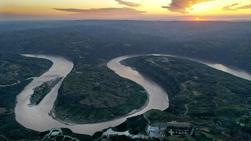 Aerial photo taken on Aug 14, 2019 shows the Qiankun Bay of the Yellow River on the border between Yanchuan county, Northwest China's Shaanxi province, and Yonghe county, North China's Shanxi province. (PHOTO / XINHUA)
Aerial photo taken on Aug 14, 2019 shows the Qiankun Bay of the Yellow River on the border between Yanchuan county, Northwest China's Shaanxi province, and Yonghe county, North China's Shanxi province. (PHOTO / XINHUA)
XINING - Thanks to transformative conservation efforts and increased rainfall, the headwaters of the Yellow River have flowed unimpeded for nearly 18 years.
Originating in Qinghai Province, the Yellow River is known as China's "Mother River" and a cradle of Chinese civilization.
Originating in Qinghai Province, the Yellow River is known as China's "Mother River" and a cradle of Chinese civilization
The two main water sources of the Yellow River are the Gyaring and Ngoring lakes, in Madoi county of Golog Tibetan autonomous prefecture of Qinghai.
Before 2005, water scarcity caused the headwaters of the river to dry up multiple times, according to Lan Yunlong, head of the Xining hydrology and water resources survey bureau, under the Yellow River Conservancy Committee.
ALSO READ: Yellow River's power of change
The river's headwaters dried up during the first four months of 2004; leading to dusty river bed.
"With the implementation of a string of projects to protect the environment, especially the construction of Sanjiangyuan National Park, the ecology in the headwaters of the Yellow River has improved," said Liu Peng, deputy director of Qinghai provincial meteorological center.
"Since 2005, the amount of incoming water to the Yellow River has risen remarkably," said Han Changpeng, the head of a protection station of the management bureau of the Sanjiangyuan National Park. "To date, the headwaters of the river have flowed unimpeded for nearly 18 years."
Sanjiangyuan, or three-river-source, is home to the headwaters of the three rivers of Yangtze, Yellow and Lancang. At an average altitude of more than 4,700 meters, Sanjiangyuan National Park is the world's highest national park covering a total area of 190,700 square km. It is home to 69 protected wildlife species, accounting for 26.8 percent of the country's total.
ALSO READ: Yellow River goes green to get clean
Compared with a decade ago, grassland coverage in the Sanjiangyuan area increased by 11 percent and grass output jumped 30 percent, official data in 2021 showed.
The runoff volume of the Yellow River, which is monitored at Huangheyan hydrological station, reached 2.974 billion cubic meters in 2019. This marked a record high since the institution started collecting data in 1955. In 2004, the runoff volume was 26.27 million cubic meters.
The size of Gyaring and Ngoring lakes both reached historic highs in 2019, increasing by 36.78 square km and 66.23 square km, respectively, from their lowest points in 2003.
Nyima Tashi, a 44-year-old herder who lives near the north shore of Gyaring Lake, has been a witness to the changes over the years.
READ MORE: Progress seen in Yellow River conservation
"The shoreline of the lake has moved closer and closer to my home over the years. The scenery out of my window is particularly beautiful during the summer," he said.


